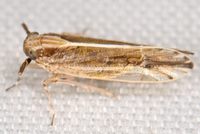
|
|
|
| synonym |
|
| description |
A large delphacid, light orange-brown overall in coloration. The wings are smoky hyaline in coloration, with a median brown band becoming stronger and wider as it extends towards the apices. The wing venation is dotted with black. The thorax is bicolored, resembling a broad pale band down the middle of the scutellum and pronotum contrasting with brown bands on the lateral margins; the pale coloration extends onto the vertex. The face is distinctly bicolored, with a brown intercarinal region and clypeus that contrasts with a pale frons. There is a large, flattened spur near the apex of the tibiae of the hind legs, characteristic for this species. Antennae are flatenned and a dark yellowish-brown color. Adults are 4.5-6.0 mm long. (Bartlett, 2013)
Nymphs are pale with mottled orange, brown and black marks across the body. Nymphs also display the large hind tibial spur that is characteristic of adults. |
| distribution |
A widespread species in Asia and Australia; adventive in Africa. It was introduced in Hawaii in 1900, and into Florida in 1982. It has since spread along the Gulf Coast to Texas and as far north as North Carolina; it has also spread throughout Central and South America and the Caribbean. (UDEL) |
| abundance |
Only recorded from a single county in the Coastal Plain, a recent arrival in the state and likely carried north by the winds of Hurricane Dorian. |
| seasonal_occurrence | |
| habitat |
Coastal areas that are somewhat in the vicinity of sugarcane. |
| plant associates |
Sugarcane |
| behavior |
Can be attracted at night with a light. |
| comments |
This species is a widespread and very important pest of sugarcane, as feeding damages the plant and leaves reddening and desiccation of the leaves. Sooty mold on honeydew excreted by the hoppers or ovipositional punctures can also damage plants. This species is a vector of Sugarcane Fiji disease virus Fijivirus (Fiji leaf gall), though this has not been documented yet in the Western hemisphere. (Bartlett, 2013)
There are multiple generations of this species every year, and adults can be found all year long. Flying adults are very mobile and can range far distances, becoming attracted to lights in large numbers. (Bartlett, 2013) |
status |
[Native:]
[Introduced:]
[Extirpated:] | | list_type |
[Official:]
[Provisional:] |
| adult_id | Unmistakable and widely known Identifiable from good quality photos of unworn specimens
Identifiable from photos showing undersides, or other specialized views [e.g., legs, face]
Identifiable only by close inspection of structural features or by DNA analysis NULL |
| nymph_id | Unmistakable and widely known Identifiable from good quality photos, especially where associated with known host plants
Identifiable from close inspection of specimens or by DNA analysis
Identifiable only through rearing to adulthood NULL |
| G_rank |
|
| S_rank |
|
| rank_comments |
|
| tribe |
|
| subgenus |
|
Species Photo Gallery for Perkinsiella saccharicida Sugarcane Planthopper |
 | Photo by: Mark Shields
Onslow Co.
Comment: |

 »
»

 »
»